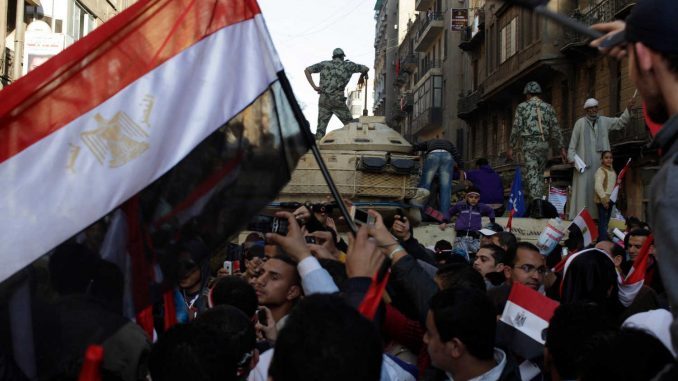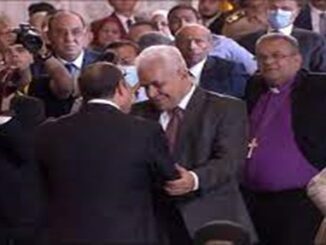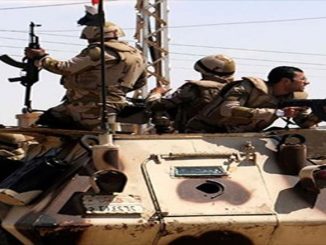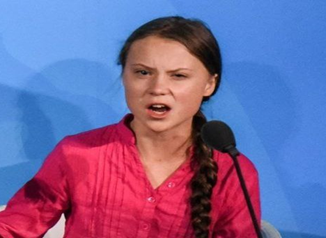
Memories of 2011’s Arab Spring, and its fragile hopes, have been revived in the minds of many Egyptians as they’ve watched a strikingly similar dynamic play out in the United States.
A brutal police killing. A wave of public anger that sends citizens rushing into the streets, clashing with the police. Journalists under attack. A president who justifies draconian measures by invoking the threat of saboteurs and terrorists.
That was the Arab Spring in Egypt almost a decade ago.
But in recent days those momentous events have been revived in the minds of many Egyptians as a strikingly similar dynamic has played out in the United States, with familiar images of flames, tear gas and anguish, even if the context is very different.
“OK, now I’m really having Egypt flashbacks,” Ashraf Khalil, an Egyptian-American journalist who covered the Arab Spring and later wrote a book about it, remarked as he posted a photo of a masked protester in America gripping a silver drum, his clenched fist held aloft.
For other Egyptians, many of the most shocking images from America’s upheaval — a lone protester standing defiantly before a phalanx of riot police, a police vehicle smashing through a crowd of protesters, a police station going up in flames — bring to mind nearly identical events and images that occurred during the 18 days of protest that culminated in the ouster of President Hosni Mubarak in 2011.
The hashtags #BlackLivesMatter and #Minnesota have trended on Egyptian social media in recent days, and the sense of solidarity has spread across the Arab world.
In the opposition enclave of Idlib, in northern Syria, two artists painted a mural of George Floyd, whose death at the hands of a white police officer set off the American protests, on the shell of a bombed-out building. “I can’t breathe,” read a slogan on the mural.
Comparisons between the events that swept the Middle East a decade ago and the explosion of unrest in America have their limitations. Egypt’s uprising stemmed from the frustration with decades of cronyism and brutal autocratic rule; American rage is a howl against inequality and racism. Although strained, American democracy still has a free press and the rule of law; unlike the Egypt of 2011, there is no dictator to topple.
Yet one striking parallel lies in the reaction of President Trump, an American leader who frequently has praised Egypt’s current authoritarian leader, President Abdel Fattah el-Sisi — even jokingly calling him “my favorite dictator” — and who now, as protests burn American cities, seems set on emulating his spirit, if not his methods.
In recent days Mr. Trump has called for violence against looters, made inflammatory suggestions that the protests were being driven by saboteurs and, in a phone call on Monday, called the protesters “terrorists” and urged American governors to “do retribution” against them.
Even at the height of the Arab Spring, Mr. Mubarak used softer language and struck a more conciliatory tone, said Ahdaf Soueif, an Egyptian writer and activist who was recently arrested for participating in street protests in Cairo. Mr. Trump “is a more crass, more vulgar version of our leaders,” she said.
At least Mr. Mubarak, she added, “occasionally made a good joke.”
Like Mr. Floyd, the face of Egypt’s uprising was also a victim of police brutality. In June 2010, two police officers pulled Khaled Said from an internet cafe in Alexandria and beat him to death. When photos of Mr. Said’s disfigured corpse circulated on social media, they set off a wave of public anger that forced Mr. Mubarak from power seven months later.
Now, just as Mr. Said’s death symbolized the impunity of Egypt’s brutal police, Mr. Floyd’s has galvanized public attention to systemic failures in the United States, said Belal Fadl, an Egyptian screenwriter and satirist who lives in New York City.
Mr. Fadl said he felt a sense of déjà vu when he saw the raw passions unleashed in American cities in recent days. “It is evidence of failure,” he said. “Evidence of a society that can no longer talk to itself.”
For some Egyptians, the turmoil in America is an unwelcome reminder of a chaotic period in Egypt that only ended when Mr. el-Sisi took over. “They’ve looted shops and torched police vehicles,” noted one el-Sisi supporter on Twitter, alongside a photo of a burning building in Minneapolis. “All they need is a Battle of the Camel and to torch the Scientific Institute” — references to well-known incidents of violence and destructiveness in Egypt in 2011.
For others, the flashbacks to 2011 are tinged by a sense of regret and failure. Not only did the ouster of Mr. Mubarak ultimately lead to Mr. el-Sisi’s harsh rule, but it changed the boundaries of how far the security forces were willing to go against civilians.
“So many red lines were crossed in Egypt during that time,” said Khaled Fahmy, an Egyptian historian at the University of Cambridge. “And we are now in a place that we could not have imagined in the worst years of Mubarak.”
If Egypt’s uprising offers one lesson to American protesters, said Nancy Okail, a visiting scholar at the Center for Development, Democracy and Rule of Law at Stanford University, it is that they need to maintain their focus on systemic change.
“They need to show this is a problem with the security apparatus as a whole, rather than one horrific incident,” she said. “If Egyptians knew that in 2011, people might not have gone out and hugged the military when they came into the streets. They would have realized that, in fact, it’s the military that is the problem.”
By: Declan Walsh, the New York Times’ Cairo bureau chief. (The article was published in the NYT on June 2 and updated on June 3, 2020)



